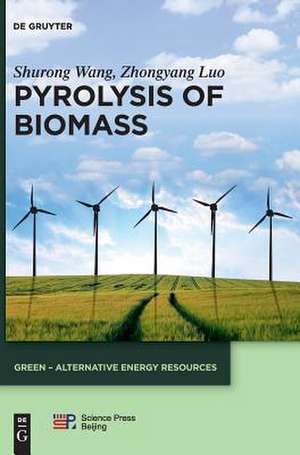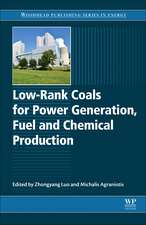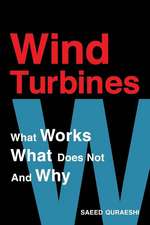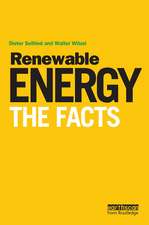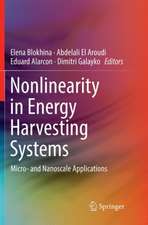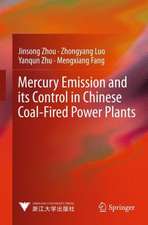Pyrolysis of Biomass: GREEN – Alternative Energy Resources
Autor Shurong Wang, Zhongyang Luo China Science Publishing & Media Ltd.en Limba Engleză Hardback – 14 aug 2016
Preț: 984.75 lei
Preț vechi: 1278.90 lei
-23% Nou
188.44€ • 197.64$ • 156.87£
Carte tipărită la comandă
Livrare economică 01-15 aprilie
Specificații
ISBN-10: 3110374579
Pagini: 360
Ilustrații: 115 schw.-w. u. 35 farb. Abb., 50 schw.-w. Tab.
Dimensiuni: 170 x 240 mm
Greutate: 0.61 kg
Editura: De Gruyter
Colecția De Gruyter
Seria GREEN – Alternative Energy Resources
Locul publicării:Berlin/Boston
Notă biografică
Shurong Wang, Zhongyang Luo, Zhejiang University, Hangzhou, China
Cuprins
Chapter 1 Biomass components and their characteristics 1.1 Biomass components 1.1.1 Ultimate and proximate analysis 1.1.2 Components composition 1.2 Cellulose 1.2.1 Structure characteristics of cellulose 1.2.2 Physico-chemical properties of cellulose 1.2.3 Cellulose model compounds and the isolation of cellulose 1.3 Hemicellulose 1.3.1 Structure characteristics of hemicellulose 1.3.2 Physico-chemical properties of hemicellulose 1.3.3 Hemicellulose model compounds and the isolation of hemicellulose 1.4 Lignin 1.4.1 Structure characteristics of lignin 1.4.2 Physico-chemical properties of lignin 1.4.3 Lignin model compounds and the isolation of lignin 1.5 Extractive 1.6 Mineral Salt 1.6.1 Compositions of mineral salts 1.6.2 Leaching of mineral salts 1.7 Moisture in raw biomass Reference
Chapter 2 Pyrolysis of cellulose 2.1 Process of cellulose pyrolysis 2.1.1 Overview of cellulose pyrolysis 2.1.2 Pyrolysis of cellulose model compounds 2.2 Effects of different parameters on the pyrolysis behavior of cellulose 2.2.1 Effects of temperature 2.2.2 Effects of residence time 2.2.3 Effects of acid pretreatment 2.2.4 Effects of other parameters 2.3 Kinetic models for cellulose pyrolysis 2.3.1 Single step model 2.3.2 Two step model 2.3.3 Multi-step model 2.4 Active cellulose 2.4.1 The acquisition and characterization of active cellulose 2.4.2 Effects of different parameters on the characteristics of active cellulose 2.5 Mechanism of cellulose pyrolysis based on product formation 2.5.1 Formation mechanism of levoglucosan 2.5.2 Formation mechanism of 5-hydroxymethl furfural 2.5.3 Formation mechanism of glycolaldehyde and 1-hydroxy-2-propanone 2.5.4 Formation mechanism of small molecular gases 2.6 Application of computational chemistry in the study of mechanism of cellulose pyrolysis 2.6.1 Simulation of cellulose monomer pyrolysis 2.6.2 Simulation of cellobiose and cellotriose pyrolysis 2.6.3 Simulation of periodically structural cellulose pyrolysis Reference Attached list
Chapter 3 Pyrolysis of hemicellulose 3.1 Process of hemicellulose pyrolysis 3.1.1 Pyrolysis of monosaccharides 3.1.2 Pyrolysis of xylan and other glycan 3.1.3 Pyrolysis of isolated hemicelluloses 3.1.4 Comparison of the pyrolysis of xylan and hemicellulose monosaccharides 3.2 Effects of different parameters on the pyrolysis behavior of hemicellulose 3.2.1 Effect of temperature 3.2.2 Effect of residence time 3.2.3 Effects of other parameters 3.3 Mechanism of hemicelluloses pyrolysis 3.3.1 Kinetic models for hemicellulose pyrolysis 3.3.2 Mechanism of hemicellulose pyrolysis based on products formation 3.3.3 Mechanism of hemicellulose pyrolysis at the molecular level Reference Attached list
Chapter 4 Pyrolysis of lignin 4.1 Process of lignin pyrolysis 4.1.1 Introduction of lignin pyrolysis 4.1.2 Pyrolysis of lignin model compounds with typical functional groups 4.1.3 Pyrolysis of various lignin 4.2 Effects of different parameters on the pyrolysis behavior of lignin 4.2.1 Effect of temperature 4.2.2 Effect of residence time 4.2.3 Effects of other parameters 4.3 Mechanism of lignin pyrolysis 4.3.1 Kinetic models for lignin pyrolysis 4.3.2 Mechanism of lignin pyrolysis based on products formation 4.3.3 Mechanism of lignin pyrolysis at the molecular level Reference Attached list
Chapter 5 Interactions of biomass components during pyrolysis 5.1 Interaction of different biomass components 5.1.1 Interaction of cellulose and hemicellulose 5.1.1 Interaction of cellulose and lignin 5.1.1 Interaction of hemicellulose and lignin 5.2 Pyrolysis of three-component mixtures 5.2.1 Thermal weight loss behavior of different three-component mixtures 5.2.2 Products distribution from pyrolysis of different three-component mixtures 5.3 Pyrolysis of detergent fibers 5.3.1 Pyrolysis behavior of different detergent fibers 5.3.2 Products distribution from pyrolysis of different detergent fibers 5.4 Influence of extractives on biomass pyrolysis 5.4.1 Pyrolysis behavior of extractives 5.4.2 Influence of the extractives on biomass pyrolysis Reference Attached list
Chapter 6 Selective pyrolysis of biomass components 6.1 Influence of mineral salts on the pyrolysis of biomass components 6.1.1 Influence of mineral salts on the pyrolysis kinetics of biomass components 6.1.2 Influence of mineral salts on the cellulose pyrolytic products distribution 6.2 Influence of zeolite catalysts on pyrolysis of biomass components 6.2.1 The characteristics and classification of zeolite catalyst 6.2.2 Influence of microporous zeolites on the pyrolysis of biomass components 6.2.3 Influence of mesoporous zeolites on the pyrolysis of biomass components 6.3 Influence of metal oxide on the pyrolysis of biomass components 6.3.1 Structural characteristics of metal oxide 6.3.2 Influence of metal oxide on the pyrolysis of biomass components Reference Attached list
Chapter 7 Pyrolysis of biomass 7.1 Overview of biomass pyrolysis 7.2 Pyrolysis of different species of biomass 7.2.1 Pyrolysis of forestry biomass 7.2.2 Pyrolysis of agricultural biomass 7.2.3 Pyrolysis of herbaceous biomass 7.2.4 Pyrolysis of aquatic biomass 7.2.5 Products distribution from pyrolysis of different species of biomass 7.3 Biomass fast pyrolysis liquefaction 7.3.1 Primary process of biomass fast pyrolysis liquefaction 7.3.2 Effects of different parameters on biomass fast pyrolysis liquefaction 7.4 Bio-oil graded catalytic upgrading 7.4.1 High-efficiency separation by molecular distillation 7.4.2 Upgrading of bio-oil molecular distilled fractions Reference
